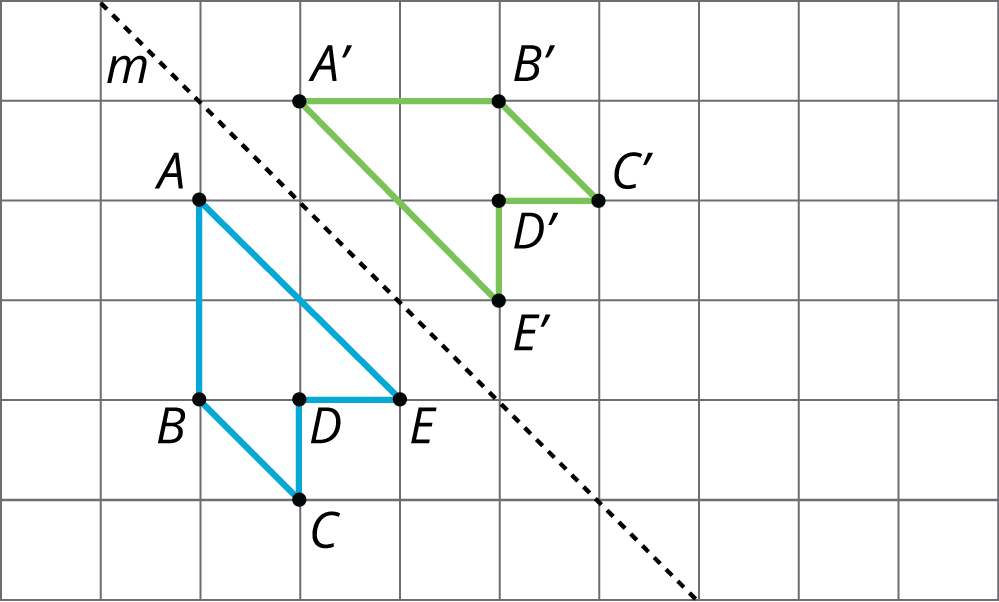Lesson 3
Making the Moves
3.1: Notice and Wonder: The Isometric Grid (10 minutes)
Warm-up
The purpose of this warm-up is to familiarize students with an isometric grid. While students may notice and wonder many things, characteristics such as the measures of the angles in the grid and the diagonal parallel lines will be important properties for students to notice in their future work performing transformations on the isometric grid. Students are not expected to know each angle in an equilateral triangle is 60 degrees, but after previous experience with supplementary angles, circles and rotations, they may be able to explain why each smaller angle is 60 degrees. Many things they notice may be in comparison to the square grid paper which is likely more familiar.
Launch
Arrange students in groups of 2. Tell students that they will look at an image. Their job is to think of at least one thing they notice and at least one thing they wonder. Display the image for all to see. Ask students to give a signal when they have noticed or wondered about something. Give students 1 minute of quiet think time, and then 1 minute to discuss the things they notice with their partner, followed by a whole-class discussion.
Student Facing
What do you notice? What do you wonder?
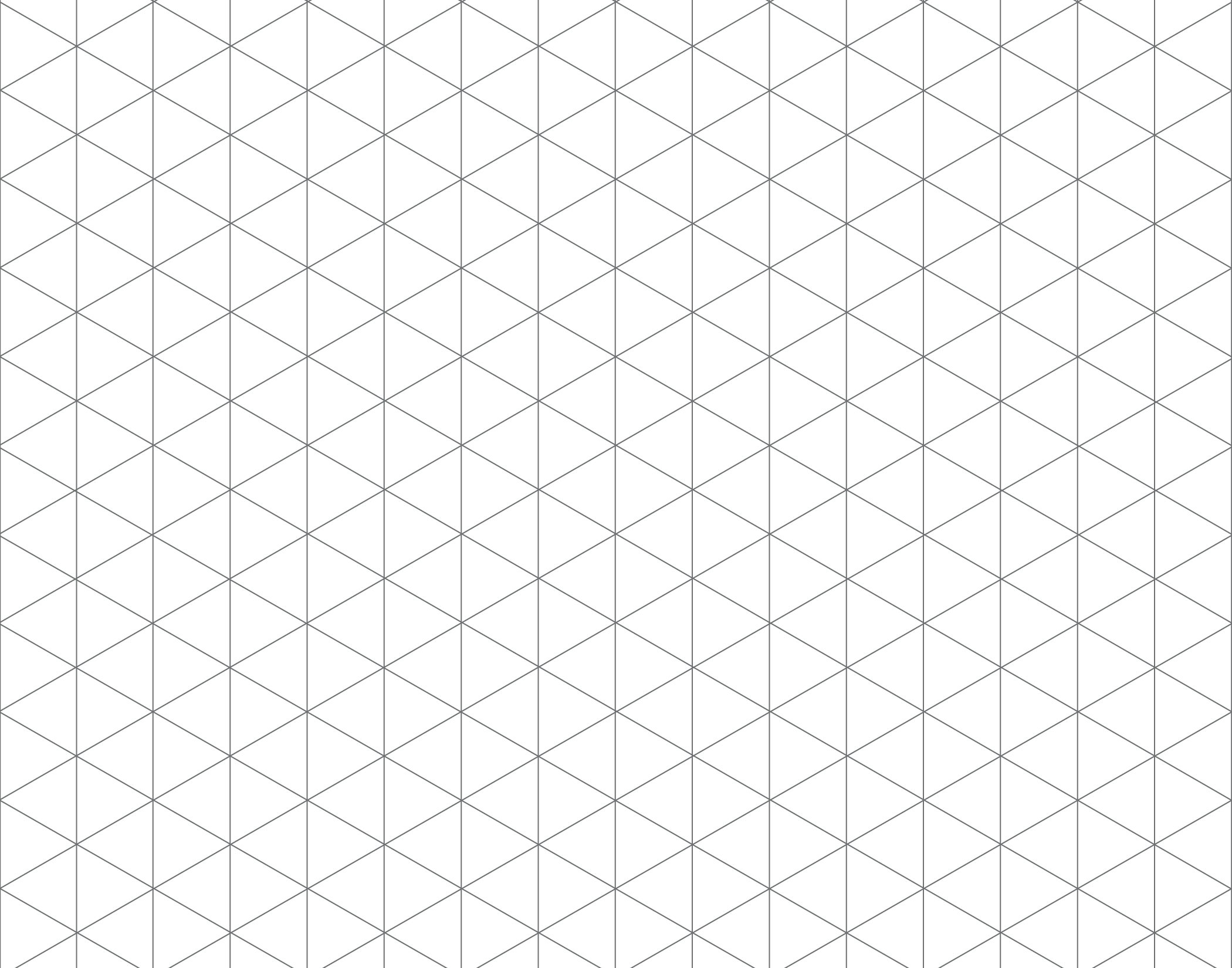
Student Response
For access, consult one of our IM Certified Partners.
Activity Synthesis
Ask students to share the things they noticed and wondered. Record and display their responses for all to see. If possible, record the relevant reasoning on or near the image, and show where each of the features students notice is located on the actual grid itself, such as triangles, angles, and line segments. After each response, ask the class if they agree or disagree and to explain alternative ways of thinking, referring back to the images each time. If angle measures do not come up during the conversation, ask them to think about how they could figure out the measure of each angle. Some may measure with a protractor, and some may argue that since 6 angles share a vertex where each angle is identical, each angle measures \(60^\circ\) because \(360 \div 6 = 60.\) Establish that each angle measures \(60^\circ\).
3.2: Transformation Information (25 minutes)
Activity
The purpose of this activity is for students to interpret the information needed to perform a transformation and draw an image resulting from the transformation.
For digital classrooms, an additional purpose of this activity is for students to learn how to use the transformation tools available in geogebra. These tools will be used throughout the unit. As they become familiar with the dynamic tools, they see that geogebra places the image of a figure based on the instructions given by the user.
Through hands-on experience with transformations, students prepare for the more precise definitions they will learn in later grades. This activity is the first time students start to use \(A’\), \(B’\), etc. to denote points in the image that correspond to \(A\), \(B\), etc. in the original figure. This is also a good activity to use the word "image" to describe the transformed figure—this can happen before, as, or after students work.
If students exploit the mathematical properties of the grid lines to draw transformed figures, they are making use of structure (MP7). In order to draw the transformed figures correctly, students must attend to the details of the given information (MP6).
Watch for students who use tracing paper and those who use properties of the grids to help decide where to place the transformed figures. Tracing paper may be particularly useful for the isometric grid which may be unfamiliar to some students.
Launch
Point out \(A’\) in the first question. Tell students we call point \(A’\) "A prime" and that, after a transformation, it corresponds to \(A\) in the original.
For students using print materials: Optionally, before students start working, demonstrate the mechanics of performing each type of transformation using tracing paper. Distribute about 10 small sheets of tracing paper to each student (or ensure they can find it in their geometry toolkits). Give students about 10 minutes of quiet work time followed by whole-class discussion.
For students using digital materials: Depending on the needs of your class, either demonstrate how each transformation tool works in the applet, or instruct students to read and follow the instructions for working the applets. It would work well to demonstrate the first, third, and fourth items and allow students to complete the other items independently.
Supports accessibility for: Conceptual processing; Visual-spatial processing
Design Principle(s): Maximize meta-awareness
Student Facing
Follow the directions below each statement to tell GeoGebra how you want the figure to move. It is important to notice that GeoGebra uses vectors to show translations. A vector is a quantity that has magnitude (size) and direction. It is usually represented by an arrow.
These applets are sensitive to clicks. Be sure to make one quick click, otherwise it may count a double-click.
After each example, click the reset button, and then move the slider over for the next question.
- Translate triangle \(ABC\) so that \(A\) goes to \(A’\).
- Select the Vector tool.

- Click on the original point \(A\) and then the new point \(A’\). You should see a vector.
- Select the Translate by Vector tool.

- Click on the figure to translate, and then click on the vector.
- Select the Vector tool.
-
Translate triangle \(ABC\) so that \(C\) goes to \(C’\).
- Rotate triangle \(ABC\) \(90^\circ\) counterclockwise using center \(O\).
- Select the Rotate around Point tool.

- Click on the figure to rotate, and then click on the center point.
- A dialog box will open; type the angle by which to rotate and select the direction of rotation.
- Click on ok.
- Select the Rotate around Point tool.
- Reflect triangle \(ABC\) using line \(\ell\).
- Select the Reflect about Line tool.

- Click on the figure to reflect, and then click on the line of reflection.
- Select the Reflect about Line tool.
-
Rotate quadrilateral \(ABCD\) \(60^\circ\) counterclockwise using center \(B\).
-
Rotate quadrilateral \(ABCD\) \(60^\circ\) clockwise using center \(C\).
-
Reflect quadrilateral \(ABCD\) using line \(\ell\).
-
Translate quadrilateral \(ABCD\) so that \(A\) goes to \(C\).
Student Response
For access, consult one of our IM Certified Partners.
Student Facing
Are you ready for more?
Try your own translations, reflections, and rotations.
- Make your own polygon to transform, and choose a transformation.
- Predict what will happen when you transform the image. Try it - were you right?
- Challenge your partner! Right click on any vectors or lines and uncheck Show Object. Can they guess what transformation you used?
Visit ggbm.at/eFeE2Veu for the applet.
Student Response
For access, consult one of our IM Certified Partners.
Launch
Point out \(A’\) in the first question. Tell students we call point \(A’\) "A prime" and that, after a transformation, it corresponds to \(A\) in the original.
For students using print materials: Optionally, before students start working, demonstrate the mechanics of performing each type of transformation using tracing paper. Distribute about 10 small sheets of tracing paper to each student (or ensure they can find it in their geometry toolkits). Give students about 10 minutes of quiet work time followed by whole-class discussion.
For students using digital materials: Depending on the needs of your class, either demonstrate how each transformation tool works in the applet, or instruct students to read and follow the instructions for working the applets. It would work well to demonstrate the first, third, and fourth items and allow students to complete the other items independently.
Supports accessibility for: Conceptual processing; Visual-spatial processing
Design Principle(s): Maximize meta-awareness
Student Facing
Your teacher will give you tracing paper to carry out the moves specified. Use \(A’\), \(B’\), \(C’\), and \(D’\) to indicate vertices in the new figure that correspond to the points \(A\), \(B\), \(C\), and \(D\) in the original figure.
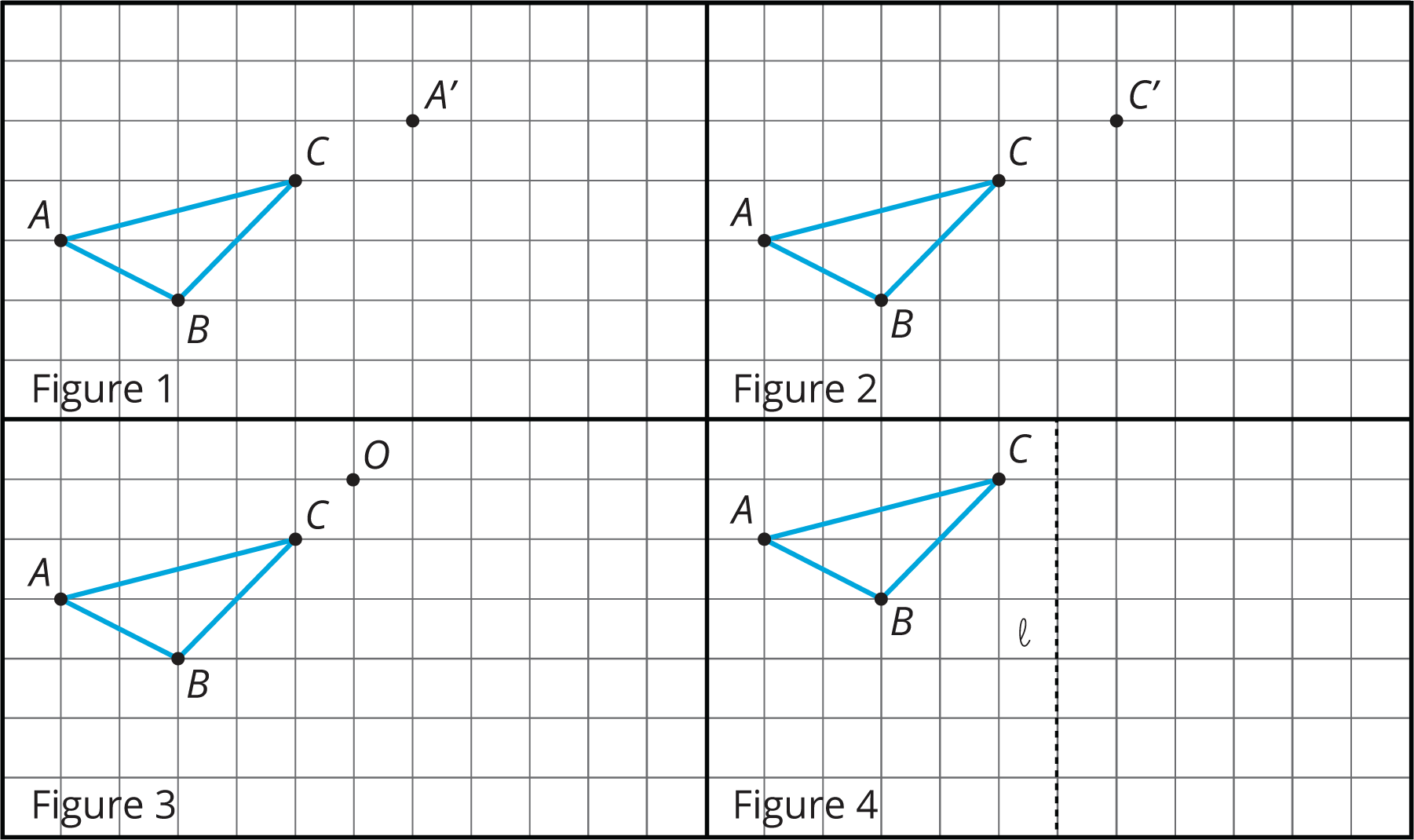
-
In Figure 1, translate triangle \(ABC\) so that \(A\) goes to \(A’\).
-
In Figure 2, translate triangle \(ABC\) so that \(C\) goes to \(C’\).
-
In Figure 3, rotate triangle \(ABC\) \(90^\circ\) counterclockwise using center \(O\).
-
In Figure 4, reflect triangle \(ABC\) using line \(\ell\).

-
In Figure 5, rotate quadrilateral \(ABCD\) \(60^\circ\) counterclockwise using center \(B\).
-
In Figure 6, rotate quadrilateral \(ABCD\) \(60^\circ\) clockwise using center \(C\).
-
In Figure 7, reflect quadrilateral \(ABCD\) using line \(\ell\).
-
In Figure 8, translate quadrilateral \(ABCD\) so that \(A\) goes to \(C\).
Student Response
For access, consult one of our IM Certified Partners.
Student Facing
Are you ready for more?
The effects of each move can be “undone” by using another move. For example, to undo the effect of translating 3 units to the right, we could translate 3 units to the left. What move undoes each of the following moves?
- Translate 3 units up
- Translate 1 unit up and 1 unit to the left
- Rotate 30 degrees clockwise around a point \(P\)
-
Reflect across a line \(\ell\)
Student Response
For access, consult one of our IM Certified Partners.
Anticipated Misconceptions
Students may struggle to understand the descriptions of the transformations to carry out. For these students, explain the transformations using the words they used in earlier activities, such as “slide,” “turn,” and “mirror image” to help them get started. Students may also struggle with reflections that are not over horizontal or vertical lines.
Some students may need to see an actual mirror to understand what reflections do, and the role of the reflection line. If you have access to rectangular plastic mirrors, you may want to have students check their work by placing the mirror along the proposed mirror line.
Working with the isometric grid may be challenging, especially rotations and reflections across lines that are not horizontal or vertical. For the rotations, you may want to ask students what they know about the angle measures in an equilateral triangle. For reflections, the approach of using a mirror can work or students can look at individual triangles in the grid, especially those with a side on the line of reflection, and see what happens to them. After checking several triangles, they develop a sense of how these reflections behave.
Activity Synthesis
Ask students to share how they found the images, and highlight the information they needed in each to perform the transformation. Invite students who used tracing paper to share how they found the images and also ask students what mathematical patterns they found. For example, for the reflection in Figure 4, ask where some intersections of grid lines go (they stay on the same horizontal line and go to the other side of \(\ell\), the same distance away). How can this be used to identify the image of \(\triangle ABC\)?
Ask students how working on the isometric grid is similar to working on a regular grid and how it is different. Possible responses include:
- Translations work the same way, identifying how far and in which direction to move the shape
- Rotations also work the same way but the isometric grid works well for multiples of 60 degrees (with center at a grid point), while the regular grid works well for multiples of 90 degrees (also with center at a grid point).
- Reflections on the isometric grid require looking carefully at the triangular pattern to place the reflection in the right place. Like for the regular grid, these reflections are difficult to visualize if the line of reflection is not a grid line.
3.3: A to B to C (15 minutes)
Activity
Students have seen images showing a sequence of transformations in the first lesson of this unit, however they have not heard the term sequence of transformations. They have also not been asked to describe the moves in the sequence using precise language. The launch of this activity introduces this term and gives students an opportunity to describe the sequence of more than one transformation.
For the second problem, encourage students to find a different sequence of transformations than the one shown in the image. Each time a reflection is mentioned, ask students where the line of reflection is located and when a rotation is mentioned, ask for the center of the rotation and the number of degrees. Monitor for students who apply different transformations (or apply transformations in a different order).
Launch
Arrange students in groups of 2, and provide access to their geometry toolkits. Display the image for all to see. Ask students if they can imagine a single translation, rotation, or reflection that would take one bird to another? After a minute, verify that this is not possible.
Ask students to describe how we could use translations, rotations, and reflections to take one bird to another. Collect a few different responses. (One way would be to take the bird on the left, translate it up, and then reflect it over a vertical line.) Tell students when we do one or more transformations in a row to take one figure to another, it is called a sequence of transformations.
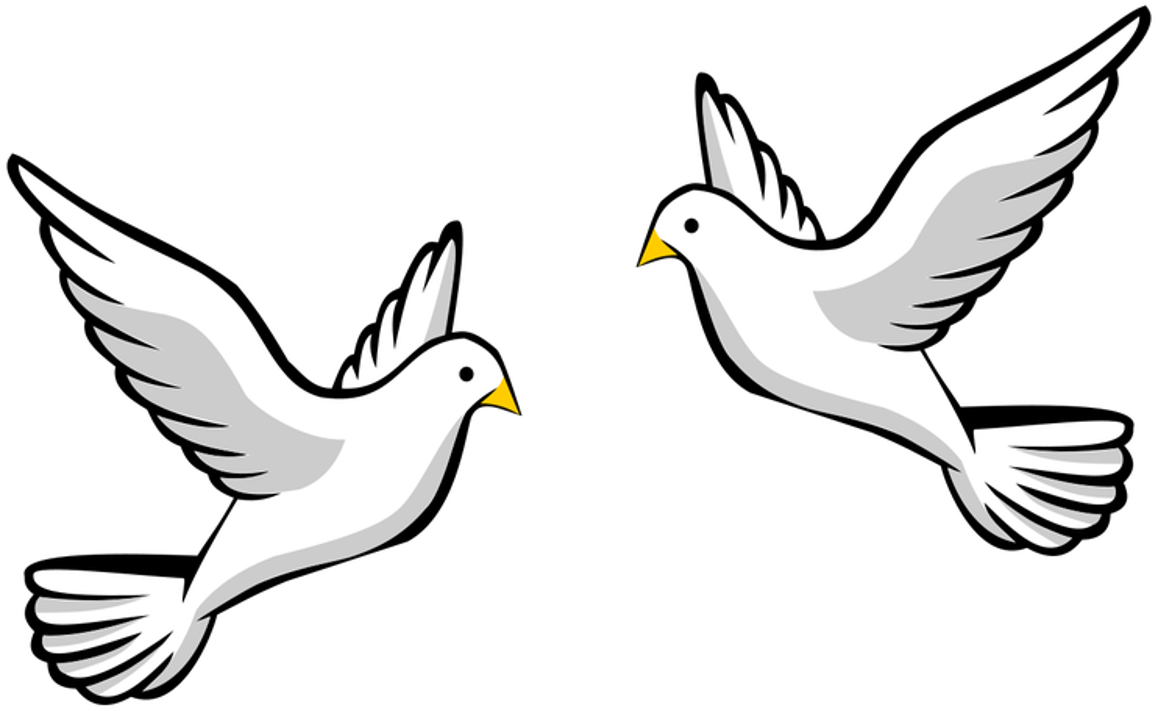
If using the digital activity, you may want to review the transformation tools in the applet. (The instructions are repeated in the activity for students' reference.)
Give students 2 minutes of quiet work time to engage in the task followed by 3 minutes to discuss their responses with a partner and complete any unfinished questions. Follow with a whole-class discussion.
Supports accessibility for: Language; Social-emotional skills
Student Facing
Here are some figures on an isometric grid. Explore the transformation tools in the tool bar. (Directions are below the applet if you need them.)
-
Name a transformation that takes Figure A to Figure B. Name a transformation that takes Figure B to Figure C.
-
What is one sequence of transformations that takes Figure A to Figure C? Explain how you know.
Translate
- Select the Vector tool.

- Click on the original point and then the new point. You should see a vector.
- Select the Translate by Vector tool.

- Click on the figure to translate, and then click on the vector.
Rotate
- Select the Rotate around Point tool.

- Click on the figure to rotate, and then click on the center point.
- A dialog box will open. Type the angle by which to rotate and select the direction of rotation.
Reflect
- Select the Reflect about Line tool.

- Click on the figure to reflect, and then click on the line of reflection.
Student Response
For access, consult one of our IM Certified Partners.
Launch
Arrange students in groups of 2, and provide access to their geometry toolkits. Display the image for all to see. Ask students if they can imagine a single translation, rotation, or reflection that would take one bird to another? After a minute, verify that this is not possible.
Ask students to describe how we could use translations, rotations, and reflections to take one bird to another. Collect a few different responses. (One way would be to take the bird on the left, translate it up, and then reflect it over a vertical line.) Tell students when we do one or more transformations in a row to take one figure to another, it is called a sequence of transformations.

If using the digital activity, you may want to review the transformation tools in the applet. (The instructions are repeated in the activity for students' reference.)
Give students 2 minutes of quiet work time to engage in the task followed by 3 minutes to discuss their responses with a partner and complete any unfinished questions. Follow with a whole-class discussion.
Supports accessibility for: Language; Social-emotional skills
Student Facing
Here are some figures on an isometric grid.
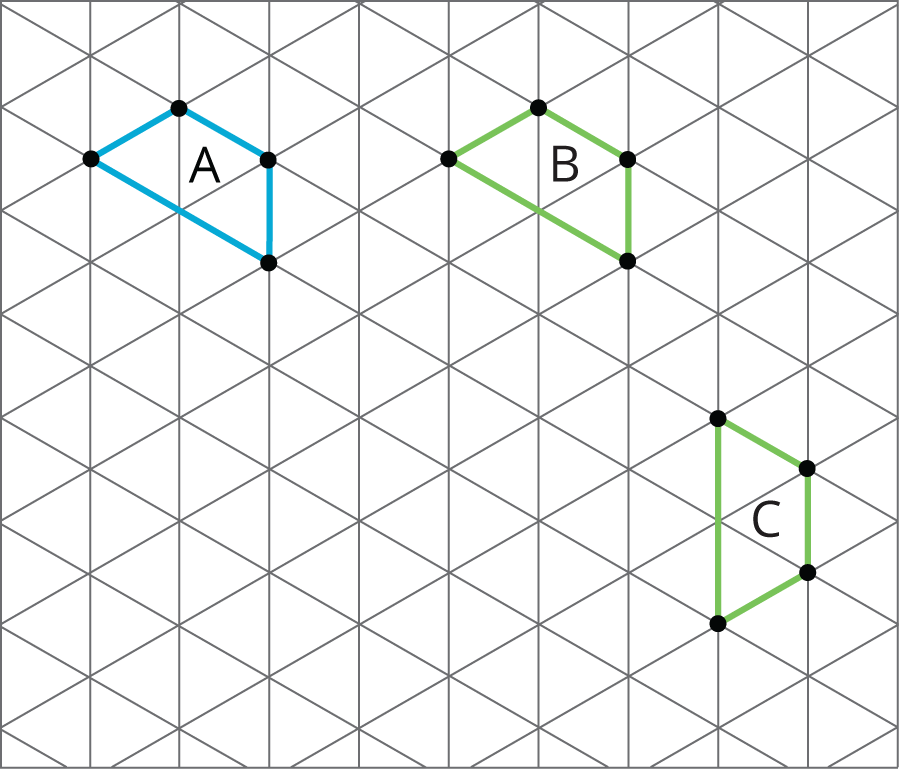
-
Name a transformation that takes Figure \(A\) to Figure \(B\). Name a transformation that takes Figure \(B\) to Figure \(C\).
-
What is one sequence of transformations that takes Figure \(A\) to Figure \(C\)? Explain how you know.
Student Response
For access, consult one of our IM Certified Partners.
Student Facing
Are you ready for more?
Experiment with some other ways to take Figure \(A\) to Figure \(C\). For example, can you do it with. . .
- No rotations?
- No reflections?
- No translations?
Student Response
For access, consult one of our IM Certified Partners.
Activity Synthesis
Select students with different correct responses to show their solutions. Be sure to highlight at least one rotation. If no students mention that, demonstrate a way to take A to C that involves a rotation. Whether or not students use the geogebra applet, it may be helpful to display the applet to facilitate discussion: ggbm.at/jqvTEgsj
- Emphasize that there are many ways to describe the translation that takes figure A to figure B. All one needs is to identify a pair of corresponding points and name them in the correct order (and to use the word “translate”).
- For students who used a reflection to take B to C, emphasize that reflections are determined by lines and we should name the line when we want to communicate about it.
- After a student or the teacher uses a rotation, emphasize that a rotation is defined by a center point and an angle (with a direction). The center point needs to be named and the angle measure or an angle with the correct measure needs to be named as well (as does the direction). Reinforce to students that when we do more than one transformation in a row, we call this a sequence of transformations.
Speaking: Math Language Routine 7 Compare and Connect. This is the first time Math Language Routine 7 is suggested as a support in this course. In this routine, students are given a problem that can be approached using multiple strategies or representations and are asked to prepare a visual display of their method. Students then engage in investigating the strategies (by means of a teacher-led gallery walk, partner exchange, group presentation, etc.), comparing approaches, and identifying correspondences between different representations. A typical discussion prompt is: “What is the same and what is different?” regarding their own strategy and that of the others. The purpose of this routine is to allow students to make sense of mathematical strategies by identifying, comparing, contrasting, and connecting other approaches to their own, and to develop students’ awareness of the language used through constructive conversations.
Design Principle(s): Maximize meta-awareness: Support sense-making
How It Happens:
-
Use this routine to compare and contrast different strategies for transforming Figure A to Figure C. Invite students to create a visual display showing how they made sense of the problem and why their solution makes sense for transforming Figure A to Figure C.
Students should include these features on their display:
- a sketch of the figures (not necessary if using the applet)
- a sketch of the figures after each transformation (not necessary if using the applet)
- a written sequence of transformations with an explanation
-
Before selecting students to show their solutions to the class, first give students an opportunity to do this in a group of 3–4. Ask students to exchange and investigate each other’s work. Allow 1 minute for each display and signal when it is time to switch.
While investigating each other’s work, ask students to consider what is the same and what is different about each approach. Next, give each student the opportunity to add detail to their own display for 1–2 minutes.
-
As groups are presenting, circulate the room and select 2–3 students to share their sequence of transformations taking Figure A to Figure C. Be sure to select a variety of approaches, including one that involves a rotation.
Draw students’ attention to the different ways the figures were transformed (e.g., rotations, reflections, and translations) and how the sequence of transformation is expressed in their explanation. Also, use the bullet points in the Activity Synthesis to emphasize specific features of translations, reflections, and rotations.
-
After the selected students have finished sharing with the whole class, lead a discussion comparing, contrasting, and connecting the different approaches.
Consider using these prompts to amplify student language while comparing and contrasting the different approaches: “Why did the approaches lead to the same outcome?”, “What worked well in __’s approach? What did not work well?”, and “What would make __’s strategy more complete or easy to understand?”
Consider using these prompts to amplify student language while connecting the different approaches: “What role does a translation play in each approach?” “Is it possible to use the all three types of transformations?”, and “What transformation do you see present in all the strategies?”
-
Close the discussion by inviting 3 students to revoice the strategies used in the presentations, and then transition back to the Lesson Synthesis and Cool-Down.
Lesson Synthesis
Lesson Synthesis
The goal for this lesson is for students to begin to identify the features that determine a translation, rotation, or reflection. Refer to the permanent display produced in a previous lesson as you discuss. To highlight the features specific to each type of transformation, consider asking:
- “Describe the two different kinds of grids in this lesson. What is the same and what is different about them?” (A square grid is all right angles and following the grid lines means moving left-right or up-down. This grid makes showing rotations that are multiples of 90 degrees simpler. An isometric grid is made up of equilateral triangles, so following grid lines from an intersection means you can go in 6 different directions instead of just 4. This grid makes showing rotations that are multiples of 60 degrees simpler.)
- "If you want to describe a translation, what important information do you need to include?" (A translation is determined by two points that specify the distance and direction of the translation.)
- "If you want to describe a rotation, what important information do you need to include?" (A rotation is determined by a center point and an angle with a direction.)
- "If you want to describe a reflection, what important information do you need to include?" (A reflection is determined by a line.)
- "What does the word transformation mean?" (Translations, rotations, and reflections, or any combination of these, that take a figure to its image.)
- "What does it mean to use a sequence of transformations?" (Using more than one basic transformation applied one after the other in a particular order.)
3.4: Cool-down - What Does It Take? (5 minutes)
Cool-Down
For access, consult one of our IM Certified Partners.
Student Lesson Summary
Student Facing
A move or combination of moves is called a transformation. When we do 1 or more moves in a row, we often call that a sequence of transformations. When a figure is on a grid, we can use the grid to describe a transformation. We use the word image to describe the figure after a transformation. To distinguish the original figure from its image, points in the image are sometimes labeled with the same letters as the original figure, but with the symbol \(’\) attached, as in \(A’\) (pronounced “A prime”) is the image of \(A\) after a transformation.
-
A translation can be described by two points. If a translation moves point \(A\) to point \(A’\), it moves the entire figure the same distance and direction as the distance and direction from \(A\) to \(A’\). The distance and direction of a translation can be shown by an arrow.
For example, here is a translation of quadrilateral \(ABCD\) that moves \(A\) to \(A’\).
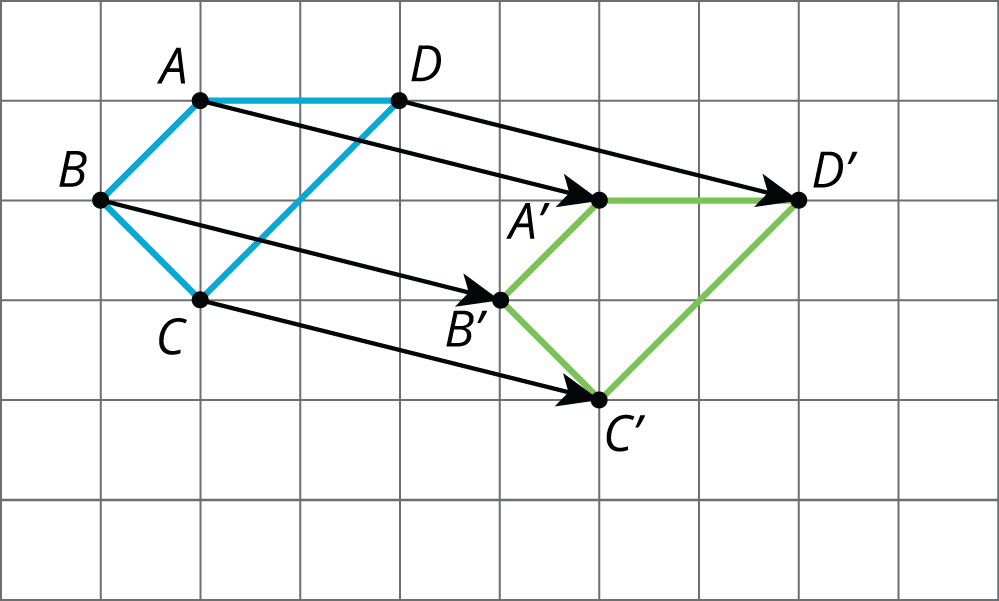
- A rotation can be described by an angle and a center. The direction of the angle can be clockwise or counterclockwise.
For example, quadrilateral \(KLMN\) is rotated 60 degrees counterclockwise using center \(P\). This type of grid is called an isometric grid. The isometric grid is made up of equilateral triangles. The angles in the triangles each measure 60 degrees, making the isometric grid convenient for showing rotations of 60 degrees.
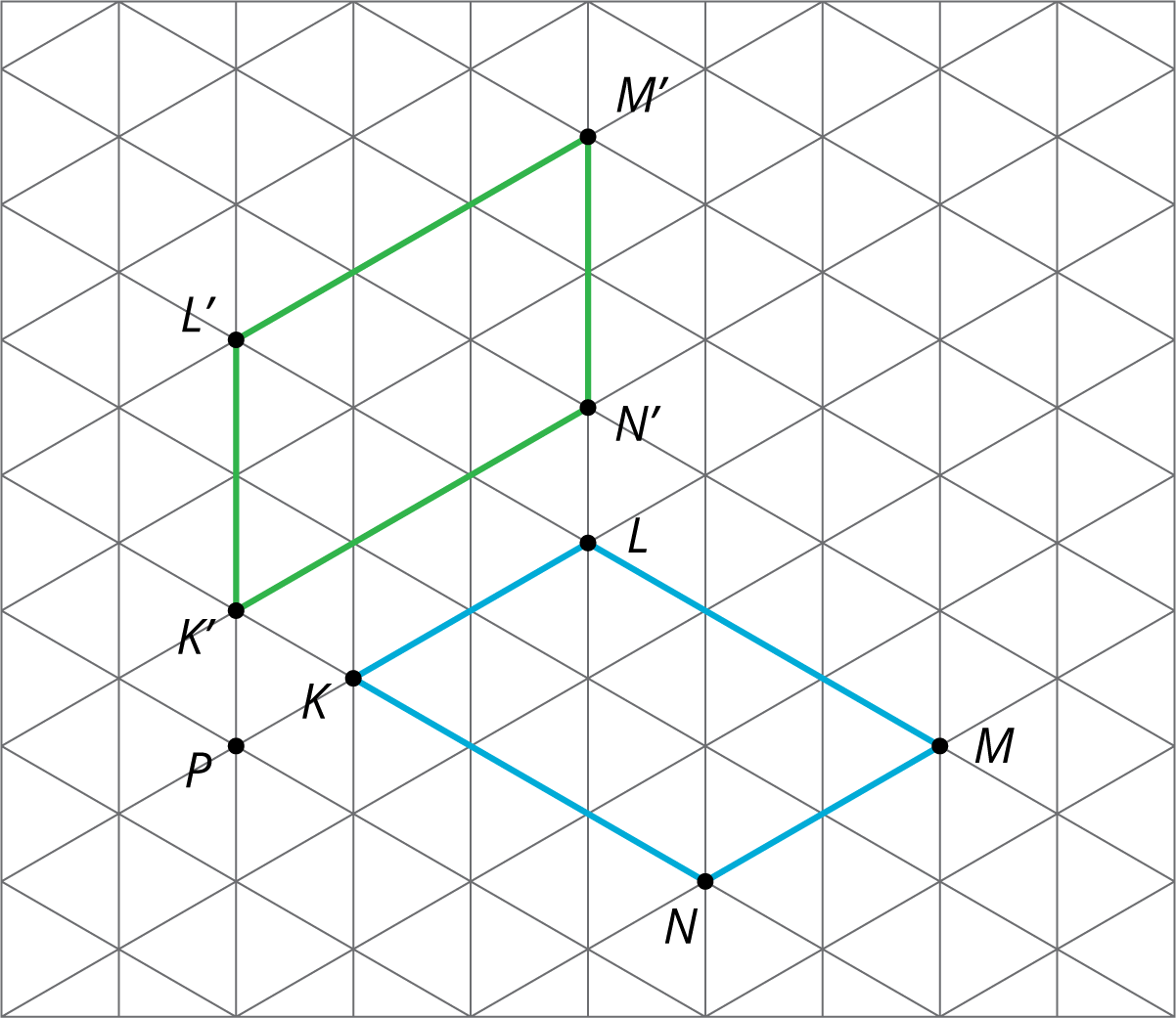
- A reflection can be described by a line of reflection (the “mirror”). Each point is reflected directly across the line so that it is just as far from the mirror line, but is on the opposite side.
For example, pentagon \(ABCDE\) is reflected across line \(m\).
